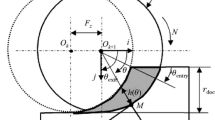Abstract
Chip formation or metal cutting is a unique large strain, high strain rate plastic deformation process. Almost all the previously reported studies of chip formation have examined the problem from the point of view of the mechanics of the deformable bodies using the mathematical theory of plasticity. This study, recognizing the heterogeneous nature of chip formation as encountered in course of machining metals, examines the problem from the metal physical or metallurgical view point. Electron microscopy studies were carried out on steel as well as nonferrous metal chips produced by shop machining conditions and compared to those chips produced by ultramicrotomy. This thin film orthogonal cutting process was employed to produce chips for microscopic examinations under well controlled and repeatable experimental conditions. The experiments carried out were designed to clarify the details of the heterogeneous plastic deformation activity occurring on the microscopic level during machining. The morphological (external surface) characteristics of the chips observed with the scanning electron microscope were correlated with the internal, dislocated structure of the chips observed by transmission electron microscopy methods. The effect of a stacking fault energy (SFE) change in an Ag-Sn alloy on chip thickness ratio(ν t) is presented for the first time, demonstrating that this deformation process is sensitive to changes in SFE. The essentially discontinuous nature of the chip formation process observed by scanning and transmission electron microscopy is analyzed with a model involving dynamic dislocation behavior in a metal in the presence of large energy dissipation arising from plastic flow to account for the observed instability.
Similar content being viewed by others
References
M. E. Merchant:J. Appl. Phys., 1944, vol. 15, p. 169.
S. Ramalingam:Trans. ASME, 1970, vol. 92, series B, no. 1, p. 93.
J. T. Black:Trans. ASME, 1971, vol. 93, series B, p. 507.
J. T. Black: Ph.D. Dissertation, University of Illinois, Urbana, Illinois, 1969.
S. Ramalingam: Ph.D. Dissertation, Univeristy of Illinois, Urbana, Illinois, 1967.
B. F. von Turkovich and J. T. Black:Trans. ASME, 1970, vol. 92, series B, p. 130.
J. T. Black:Trans. ASME, 1972, vol. 94, series B, p. 307.
S. Ramalingam and J. T. Black:Trans. ASME, 1972, vol. 94, series B, p. 1215.
S. Ramalingam and K. J. Trigger:Advances in Machine Tool Design and Research, p. 565, Pergamon Press, London, 1971.
B. F. von Turkovich and S. Calvo.Proc. 9th Int. MTDR Conf., p. 1051, Pergamon Press, London, 1968.
B. F. von Turkovich:ASTME Technical Paper No. MR- 71-903, 1971.
A.W. Ruff, Jr. and L. K. lves:Acta Met., 1967, vol. 15, p. 189.
A. W. Ruff, Jr. and L, K. Ives:Acta Met., 1969, vol. 17, p. 1045.
V. A. Phillips:Direct Observations of Imperfections in Electron Microscopy, Newkirk and Wernick, eds., p. 174, Wiley, 1962.
M. Ahlers and L. F. Vassamillet:J. Appl. Phys., 1968, vol. 39, p. 3592.
D. M. Turley:J. Inst. Metals, 1971, vol. 99, p. 271.
L. E. Murr:Electron Optical Applications in Materials Science, p. 365, McGraw Hill, New York, 1970.
B. F. von Turkovich:Trans. ASME, 1970, vol. 92, series B, p. 151.
S. Kobayashi and E. G. Thomsen:Trans. ASME, 1959, vol. 81, series B, p. 251.
J. Bailey and P. B. Hirsch:Phil. Mag., 1960, vol. 5, p. 485.
S. Howe, B. Liebman, and K. Lücke:Acta Met., 1961, p. 625.
A. Seeger, S. Mader, and H. Kronmuller:Electron Microscopy and Strength of Crystals, p. 666, Interscience Publishers, New York, 1963.
F. Jovane, J. Carro-Cao, and J. Pomey:C.R. Acad. Sci., Paris, t. 272, p. 629, 1971.
J. C. M. Li:Strengthening of Metals, D. Peckner, ed., pp. 1 -77, Reinhold, New York, 1964.
K. J. Trigger and B. T. Chao:Trans. ASME, 1951, vol. 70, p. 57.
J. J. Jonas, H. J. McQueen, and W. A. Wong: inDeformation Under Hot Working Conditions, pp. 49–60, ISI Publication No. 108, Iron and Steel Inst., London,1968.
C. M. Sellers and W. A. McG. Tegart:Mem. Sci. Rev. Met., 1966, vol. 63, p. 731.
Author information
Authors and Affiliations
Additional information
N. Y. J. T. BLACK, formerly with the Department of Mechanical Engineering, University of Vermont, Burlington Vt.
Rights and permissions
About this article
Cite this article
Ramalingam, S., Black, J.T. An electron microscopy study of chip formation. Metall Trans 4, 1103–1112 (1973). https://doi.org/10.1007/BF02645614
Received:
Issue Date:
DOI: https://doi.org/10.1007/BF02645614



